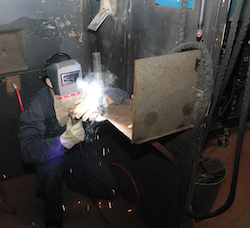The welding industry has many codes and standards that must be met in order to have safe and reliable welding processes. Welding codes facilitate a safe work environment and the enforcement of proper procedure. Safety is an important focus when it comes to welding. Codes and standards provide the operator with guidelines to perform a safe weld and pass inspection. This helps to guarantee the safety of the welder by reducing long term health concerns such as exposure to dangerous chemicals and gases. Codes are developed by various engineering and technical committees which can modify codes periodically via a review process; this ensures the codes are up to date with the industry and government regulations. 
Some of the most well-known and used codified systems come from ANSI and ASME. The American National Standards Institute (ANSI) creates and promulgates guidelines that effect businesses involved in construction, dairy and agriculture, energy distribution, and more. ANSI isthe official US representative to the International Organization for Standardization (ISO), whose codes and standards are recognized and enforced across the globe. The American Society of Mechanical Engineering (ASME) focuses on regulations for mechanical engineering, most of which are in sync with ANSI. Codes under this committee include requirements on design, materials, fabrication, completing, testing and inspection.
ANSI 31.1, Section III, ASME, US Navy and Military codes require a 1/16 inch gap for socket welds. This minimum gap was determined after extensive testing and calculation on how much thermal expansion can occur in a socket weld. This characteristic directed engineers to create a gap large enough for the pipe to correctly fit into the joint. The minimum gap requirement allows the pipe to expand without any damage.
Aquasol Corporation’s water soluble socket weld spacer ring, SoluGap, meets the robust standards of the industry. This product is rapidly becoming the industry standard as it is compatible with any metal and dissolves upon contact with water. With SoluGap, the risk of contaminating the weld with different metals is eliminated. The 1/16 inch gap provided by SoluGap mitigates the probability of human error as there is no need for careful scribing, measuring, or fitting as is done in traditional methods. SoluGap is also available in 1/8 inch, which some industries and applications require. The easy to install SoluGap is specified by major companies like Tecnicas Reunidas, Chevron Corporation, Egyptian Refining Company, Unipetrol, and more.
© 2025 Aquasol Corporation. All Right Reserved.
